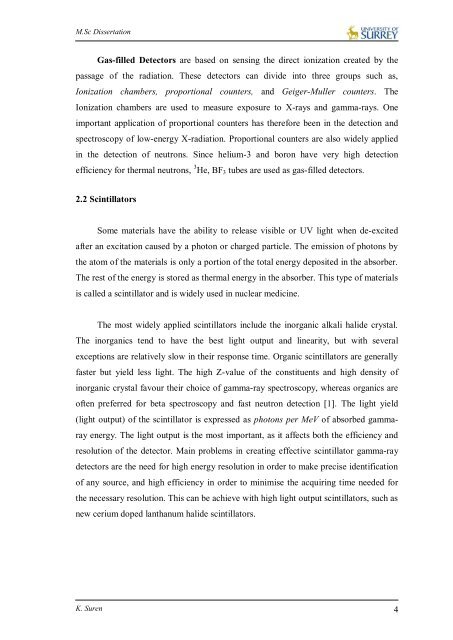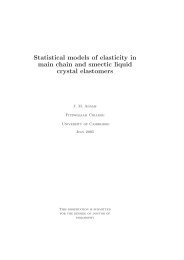Suren Kandasamy Dissertation.pdf - University of Surrey
Suren Kandasamy Dissertation.pdf - University of Surrey
Suren Kandasamy Dissertation.pdf - University of Surrey
Create successful ePaper yourself
Turn your PDF publications into a flip-book with our unique Google optimized e-Paper software.
M.Sc <strong>Dissertation</strong>Gas-filled Detectors are based on sensing the direct ionization created by thepassage <strong>of</strong> the radiation. These detectors can divide into three groups such as,Ionization chambers, proportional counters, and Geiger-Muller counters. TheIonization chambers are used to measure exposure to X-rays and gamma-rays. Oneimportant application <strong>of</strong> proportional counters has therefore been in the detection andspectroscopy <strong>of</strong> low-energy X-radiation. Proportional counters are also widely appliedin the detection <strong>of</strong> neutrons. Since helium-3 and boron have very high detectionefficiency for thermal neutrons, 3 He, BF 3 tubes are used as gas-filled detectors.2.2 ScintillatorsSome materials have the ability to release visible or UV light when de-excitedafter an excitation caused by a photon or charged particle. The emission <strong>of</strong> photons bythe atom <strong>of</strong> the materials is only a portion <strong>of</strong> the total energy deposited in the absorber.The rest <strong>of</strong> the energy is stored as thermal energy in the absorber. This type <strong>of</strong> materialsis called a scintillator and is widely used in nuclear medicine.The most widely applied scintillators include the inorganic alkali halide crystal.The inorganics tend to have the best light output and linearity, but with severalexceptions are relatively slow in their response time. Organic scintillators are generallyfaster but yield less light. The high Z-value <strong>of</strong> the constituents and high density <strong>of</strong>inorganic crystal favour their choice <strong>of</strong> gamma-ray spectroscopy, whereas organics are<strong>of</strong>ten preferred for beta spectroscopy and fast neutron detection [1]. The light yield(light output) <strong>of</strong> the scintillator is expressed as photons per MeV <strong>of</strong> absorbed gammarayenergy. The light output is the most important, as it affects both the efficiency andresolution <strong>of</strong> the detector. Main problems in creating effective scintillator gamma-raydetectors are the need for high energy resolution in order to make precise identification<strong>of</strong> any source, and high efficiency in order to minimise the acquiring time needed forthe necessary resolution. This can be achieve with high light output scintillators, such asnew cerium doped lanthanum halide scintillators.K. <strong>Suren</strong> 4
















